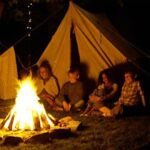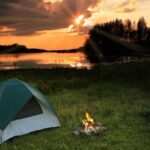by Liz Childers
Yesterday, we posted the first part of our interview with Cathy Farneman, who creates and sells herbal products for medicinal purposes. In this second part of our interview, Cathy talks about how campers can use plants in the wilderness for first aid. If you want to learn more about holistic medicines or include a few products in your wilderness first aid kit, pay a visit to Cathy’s website.
For someone who is unfamiliar with using plants for medicine or first aid, how should they begin to learn?
I feel the very best way to learn this is to find a teacher and take classes, either one-on-one or in a group. You don’t have to start out gathering wild plants to use for medicines. You can purchase herbal medicinal products from someone who makes reliable products, use them, and thus get to know what works for you and gain a confidence in using the medicinal properties of plants. From there you might feel a need to start producing your own medicinal plant products and first aid items. I meet a lot of people who work in wilderness therapy programs for adults and youth. They are out in the wilderness so much that they develop a desire to be able to use the plants around them for first aid and other medicinal needs. They take my classes at camps and go back out and use the things they learn.
This mushroom, the Haploporous odoratus, has properties that relieve headaches.

If a camper wants to use holistic medicines, what should they keep in their wilderness first aid kit?
Of course, that would depend entirely upon his/her needs. I can only share with you what I keep in my wilderness first aid kit. There are basic needs everyone might have, such as cuts, burns, bruises, bleeding, nausea, allergic reactions to plants, insect bites and stings, etc. I tell my students to first make a list of what they feel their needs would be. Then, think about what they would purchase at a pharmacy to fill those needs. Then, investigate what plants could furnish those medicinal properties instead of using the pharmaceuticals. Don’t forget the basic first aid procedural items such as sterile gauze pads, tweezers, scissors/knife, a sling, roller gauze and tape. These things can be improvised but in an emergency it is comforting to have them to use without having to improvise.
In addition to procedural items, I carry my own homemade Bite and Sting Salve, which is something to relieve the pain or itch and reaction of insect bites and stings; my Rub Away Topical Analgesic Salve, which is something for bruises, sprains, strains and pain in muscles, ligaments, tendons and joints; a jar of honey to dress burns and wounds in order to stop bleeding, stop pain, prevent or stop infection and facilitate cell regeneration for faster healing; powdered cayenne pepper to stop bleeding and prevent infection; candied ginger root for nausea control; a bottle of sterile water for wound washing, dehydration, relief of stroke and heart attack symptoms, drunk with a little powdered cayenne pepper dissolved in it for shock and more; White Willow Bark (Salix alba) tincture for pain, inflammation, fever reduction; Plantain (Plantago Major) tincture to stop allergic reactions, stop internal bleeding and neutralize venoms; Echinacea (angustafolia and purperea) tincture to stimulate immune response and also to neutralize rattlesnake venom; Osha Root (Ligusticum porteri) pieces to chew in case of sore throat, cough, lung or bronchial congestion and asthma; a piece of “migraine mushroom” (Haploporous odoratus); and several personal need items to address health concerns that might arise. If you need specialized medications that are prescribed for you, you should carry a supply of those as needed.
Juniper, Fir, and Pine Needles can be used to to make an antiseptic wash for wounds.
What are a few common plants that people could learn to identify and use in the wilderness?
It would depend upon where you are and what grows there. However, for first aid purposes, there are a few plants that can be found almost everywhere, or you will be able to find something related with the same medicinal properties. Climate can be the determining factor, such as if you are above timberline in altitude, or in the desert. Some species of Plantain are found almost everywhere, although the desert species only grow in the spring if there has been rain. They are a perennial, meaning they are unavailable in winter, so you must harvest leaves and dry them for winter use. Oak species are found in so many places and the tannic acid found in oak leaves and bark can be used topically to stop bleeding and as a disinfectant/antiseptic wash, if made into a tea. In the west we have Oregon Grape root and in the Southeast there is Yellow root; both are used in the same way as oak. The berberine alkaloid in the root will stop bleeding and act as an antiseptic wash to stop or prevent infection. Taken sparingly internally, it will purify the blood and normalize blood chemistry. Pine, Fir, Cedar and Juniper needles all can be used to make an antiseptic wash for wounds, as well as a pleasant tea to cleanse the digestive system, calm upset stomach and furnish needed vitamin C.

What are your most popular products?
My “products” evolved from personal and family needs. I also use my products – tinctures, salves, powdered herbs, herb infused oils – as visual aides when teaching my class members what to do with the medicinal plants. My students often want to purchase what I make even though they are learning to make their own. By far the most popular products are a tincture compound I call “Cold and Flu Tincture Formula” and two of my salves: Bite and Sting Salve and Rub Away Topical Analgesic Salve, which relieves pain, inflammation and swelling in muscles and joints.
Please note: The FDA does not approve the above statements about the healing properties of plants and how I use them. They are from personal experiences and those of others and, in some cases, historical information. They should not be construed as advice to you for medicinal purposes.”



